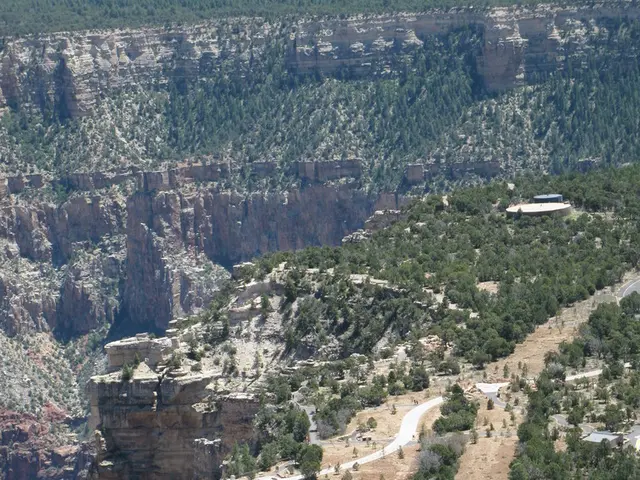National park adventures: a preparatory guide
Navigating Nature's Realm: Crucial Skills and Financial Guidelines for Adventurers in National Parks
Embarking on a national park excursion can be a breathtaking, memorable experience, replete with resplendent landscapes, unique animal encounters, and the opportunity to disconnect from the daily grind. Yet, even seasoned travelers can find themselves in tricky situations without the right prep. Whether you're planning a quick day hike or a multi-day backcountry escapade, mastering wilderness survival and financial planning is crucial for an unforgettable adventure.
Navigation Blunders to Steer Clear Of
One of the most common blunders park-goers make is excessively relying on GPS. While navigation apps and online maps can be helpful, they should never be your sole guidance system. Many national parks boast limited cell service, and batteries can run out quickly.
Instead, acquiring a detailed map and compass is indispensable, especially for those venturing into remote areas. National park visitor centers often offer free or low-cost topographic maps, which help navigate trails and identify crucial landmarks.
Hikers must also familiarize themselves with trail markers, such as blazes, signposts, or rock cairns. mastering these symbols guards against unwanted detours. Should you become lost, staying calm, conserving energy, and backtracking is essential.
H2O Essentials
Adequate hydration is vital when spending time outdoors. National parks, particularly desert parks like Death Valley and Arches, have few reliable water sources. Always carry enough water for your journey, and bring extra in case of emergencies.
If planning to refill from natural sources, it's essential to treat the water before consumption to avoid illness. Boiling is the most effective method, but portable filters and water purification tablets are nomadic alternatives. Streams, lakes, and rivers may appear clean, but they can harbor bacteria, parasites, or other harmful contaminants.
Dehydration is one of the most prevalent dangers in national parks. Signs of dehydration include dizziness, fatigue, and confusion. To combat dehydration, drink water consistently, even before you feel thirsty, and limit caffeine and alcohol consumption.
Animal Encounters - Tread Lightly
National parks host a variety of wildlife, and animal encounters are part of the experience. Maintaining a safe distance and following park regulations ensures a harmonious connection between you, the animals, and the environment.
Large mammals, such as bears, bison, and moose, can be unpredictable, especially if they feel threatened. Visitors should remain at least 100 yards away from bears and wolves and 25 yards from other large animals. Feeding animals is strictly prohibited, as it can make animals aggressive or dependent on human food.
In bear country, hikers should carry bear spray and know how to use it effectively. Proper food storage is also crucial, with many parks mandating the use of bear-proof containers or hanging food away from campsites. Observing these precautions keeps visits safe for both people and wildlife.
Emergency Preparedness - Be Ready for Anything
Even the best-laid plans can encounter unforeseen challenges. Adverse weather conditions, injuries, and lost gear are just a few examples of emergencies that can arise in national parks. Being prepared can significantly impact how you handle situations.
Before venturing out, share your itinerary with a trusted friend or family member, including your planned route, estimated return time, and emergency contact information. Carrying a first aid kit is essential, containing basic supplies like bandages, antiseptic wipes, pain relievers, and blister treatments.
Weather conditions can shift quickly in some parks. Mountainous areas, like Rocky Mountain National Park or Yosemite, can experience abrupt temperature drops, thunderstorms, or even snow in late summer. Checking the weather forecast before your trip and bringing suitable clothing can help you remain comfortable and protected.
If lost or injured, stay put and make yourself noticeable. Rescuers are more likely to locate you if you don't meander off the trail. Use a whistle, mirror, or brightly colored clothing to attract attention.
Finance-Wise Wanderlust - be Moolah Mindful
National park adventures can involve unexpected costs, from emergency lodging to vehicle repairs. Proper planning ensures a financially worry-free journey.
One common question wanderers ask is, "how much money should I have in my checking account?" The answer depends on trip length, transportation, and accommodations. However, setting aside extra funds for emergencies is always recommended.
Parks in remote areas, such as Denali or Big Bend, have limited access to ATMs and credit card machines. Bringing a mix of cash and cards ensures that you can cover costs, even in places where digital payments are not accepted.
Travel insurance is another consideration, particularly for those planning extended trips or international visitors. Policies may cover trip cancellations, medical emergencies, and lost gear, giving peace of mind while exploring the wilderness.
Campground Camaraderie - safety First
Camping in a national park offers an unparalleled connection with nature, but safety guidelines are essential to create a pleasant and secure experience. Choosing the appropriate campsite saves you from harsh weather, wildlife encounters, and other hazards.
Always select flat, elevated ground for your tent to prevent flooding in rainy conditions. Maintain a safe distance from rivers, cliffs, and dead trees, avoiding potential falling-branch danger.
Fire safety is crucial. Many parks have fire restrictions during dry seasons to prevent wildfires. If campfires are allowed, use designated fire rings and ensure your fire is completely extinguished before leaving the site.
Proper food storage is essential in wildlife-active parks, such as Yellowstone or Glacier National Park. Cooking and eating should be done away from sleeping areas, and all food should be stored in bear-proof containers or lockers when not in use.
Adventuring's A-Z - be Prepared, be Informed
National parks offer a multitude of opportunities for personal exploration. A basic understanding of wilderness survival skills, animal interactions, and financial planning guarantees a safe and rewarding experience.
Before plunging into the wilderness, do your homework:
- Research park regulations and weather conditions.
- Plan for emergencies and carry a survival kit.
- Utilize topographic maps, trail markers, and compasses for navigation.
- Obey wildlife regulations and respect animal habitats.
- Budget appropriately, set aside emergency funds, and consider travel insurance.
- Follow camping guidelines to ensure a peaceful and secure stay.
Whether you're traversing the Grand Canyon, camping in Great Smoky Mountains National Park, or discovering the Everglades, being well-prepared unlocks the best parts of your national park adventure.
References:
- National Park Service. (n.d.). Enjoy Your Visit. Retrieved from National Park Service
- The Mountaineers. (2019). Hiking Guide. Retrieved from The Mountaineers
- National Park Traveler. (n.d.). National Park Entrance Fees & Free Days 2021. Retrieved from National Park Traveler
- National park adventures promise resplendent landscapes and unique wildlife encounters, offering a chance to disconnect from daily life.
- GPS reliance in national parks can lead to navigation blunders due to limited cell service and draining batteries.
- A detailed map and compass are indispensable for remote hiking, complementing trail markers like blazes, signposts, or rock cairns.
- Staying calm, conserving energy, and backtracking is vital when lost amidst the wilderness.
- Adequate hydration is crucial in national parks, especially in desert regions like Death Valley and Arches, where water sources can be scarce.
- Water treatment methods, such as boiling, filters, or purification tablets, are essential to avoid water-borne illnesses.
- Dehydration symptoms include dizziness, fatigue, and confusion, making consistent water intake vital.
- Maintaining a safe distance from wildlife, following park regulations, and avoiding feeding animals helps ensure a harmonious experience.
- Large mammals, such as bears, bison, and moose, require a greater distance, with a minimum safety gap of 100 yards for bears and wolves, and 25 yards for other large animals.
- Emergency preparedness is crucial to handle sudden challenges, such as weather changes, injuries, or lost gear.
- Sharing your travel itinerary with a trusted friend or family member can speed up rescue should an emergency arise.
- A first aid kit is essential for a basic supply of bandages, antiseptic wipes, pain relievers, and blister treatments.
- Mountainous parks, like Rocky Mountain National Park or Yosemite, may experience abrupt weather changes, so checking the forecast is vital to stay comfortable and protected.
- Finances play a crucial role in national park adventures, with unexpected costs such as emergency lodging or vehicle repairs.
- Adequate funds in your checking account, a mix of cash and cards, and travel insurance can ensure financial peace of mind during your journey.
- Camping in national parks involves simple safety guidelines, like choosing flat, elevated ground for tents and maintaining a safe distance from water sources and dead trees.
- Fire safety, proper food storage, and following park campsite regulations contribute to a pleasant and secure camping experience.





